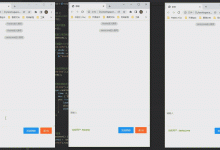Java集合框架
一、集合框架的概述
- 集合、数组都是对多个数据进行存储操作的结构,简称:
Java
容器。
说明:此时的存储,主要指的是内存层面的存储,不涉及到持久化的存储(.txt
,
.jpg
,
.avi
,数据库中)。
- 数组在存储多个数据方面的特点:
- 一旦初始化后,其长度就确定了。
- 需要指定元素的类型。
比如:String[] arr;
int[] arr1;
Object[] arr2
。
- 数组在存储多个数据方面的缺点:
- 一旦初始化,其长度就不能修改。
- 数组中提供的方法非常有限,对于添加、删除、插入数据等操作,非常不变,同时效率不高。
- 获取数组中实际元素的个数。
- 数组存储数据的特点:有序、可重复。对于无序、不可重复的需求,不能满足。
二、Java集合可分为 Collection 和 Map 两种体系
①
Collection
接口:单列集合,定义了存取一组对象的方法的集合 。用来存储一个一个的对象。
-
List
:元素有序、可重复的集合
ArrayList
、
LinkedList
、
Vector
-
Set
:元素无序、不可重复的集合
HashSet
、
LinkedHashSet
、
TreeSet
②
Map
接口:双列集合,保存具有映射关系“key-value对”的集合。用来存储一对的数据。
-
HashMap
、
LinkedHashMap
、
TreeMap
、
Hashtable
、
Properties
Collection接口中的方法使用
add(Object e)
:将元素e添加到集合
coll
中。
size()
:获取添加的元素的个数。
addAll(Collection coll)
:将
coll
集合中的元素添加到当前的集合中。
clear()
:清空集合元素。
56cisEmpty()
:判断当前集合是否为空。
public void testCollection(){Collection coll = new ArrayList();//add(Object e):将元素e添加到集合coll中coll.add(\"AA\");coll.add(\"BB\");coll.add(\"CC\");coll.add(123);// 自动装箱了coll.add(new Date());//size():获取添加的元素的个数System.out.println(coll.size());// 5//addAll(Collection coll):将coll集合中的元素添加到当前的集合中Collection coll2 = new ArrayList();coll2.add(\"CC\");coll2.add(123);coll.addAll(coll2);System.out.println(coll.size());System.out.println(coll);//clear:清空集合元素coll.clear();// isEmpty():判断当前集合是否为空System.out.println(coll.isEmpty());}
contains(Object obj)
:是通过元素的equals方法来判断是否 是同一个对象。
向
Collection
接口的实现类的对象中添加数据
obj
时,要求
obj
所在类要重写
equals()
。
public void testCollection2() {Collection coll = new ArrayList();coll.add(\"AA\");coll.add(123);coll.add(new String(\"Tom\"));103ccoll.add(false);Person p = new Person(\"Jerry\", 20);coll.add(p);coll.add(new Person(\"Snake\",20));//contains():判断当前集合是否包含Obj// 我们在判断时会调用obj对象所在的equals()。boolean contains = coll.contains(\"AA\");System.out.println(contains);System.out.println(coll.contains(new String(\"Tom\")));System.out.println(coll.contains(p));System.out.println(coll.contains(new Person(\"Snake\", 20)));}
containsAll(Collection c)
:也是调用元素的equals方法来比 较的。拿两个集合的元素挨个比较。
Collection coll1 = Arrays.asList(123,\"AA\");System.out.println(coll.containsAll(coll1));// true
remove(Object obj)
:通过元素的
equals
方法判断是否是 要删除的那个元素。只会删除找到的第一个元素 。
removeAll(Collection coll)
:取当前集合的差集 7、取两个集合的交集。
public void test3() {// remove(Object obj)Collection coll = new ArrayList();coll.add(\"AA\");coll.add(123);coll.add(false);coll.add(new String(\"Tom\"));coll.add(new Person(\"Jerry\", 20));boolean remove = coll.remove(123);coll.remove(new Person(\"Jerry\", 20));System.out.println(remove);// trueSystem.out.println(coll);// [AA, false, Tom]// removeAll(Collection coll1):从当前集合中移除coll1中所有的元素Collection coll1 = Arrays.asList(\"AA\",new String(\"Tom\"));coll.removeAll(coll1);System.out.println(coll);// [false]}
retainAll(Collection coll)
:获取当前集合和
coll
集合的交集,并返回给当前集合。
equals(Object obj)
:集合是否相等 。要向返回true,需要当前集合和形参集合的元素都相同。
public void test4() {Collection coll = new ArrayList();coll.add(\"AA\");coll.add(123);coll.add(false);coll.add(new String(\"Tom\"));coll.add(new Person(\"Jerry\", 20));// coll.retainAll(Collection coll):获取当前集合和coll1集合的交集,并返回给当前集合。Collection coll1 = Arrays.asList(123,\"AA\",\"Snake\");coll.retainAll(coll1);System.out.println(coll);// [AA, 123]// equals(Object obj):要向返回true,需要当前集合和形参集合的元素都相同。Collection coll2 = new ArrayList();coll2.add(\"AA\");coll2.add(123);System.out.println(coll.equals(coll2));// true}
hashCode():
返回当前对象的哈希值。
- 集合→ 数组:
toArray()
- 数组→ 集合:调用
Arrays
类的静态方法
asList()
public void test5() {Collection coll = new ArrayList();coll.add(\"AA\");coll.add(123);coll.add(false);coll.add(new String(\"Tom\"));coll.add(new Person(\"Jerry\", 20));// hashCode():返回当前对象的哈希值System.out.println(coll.hashCode());// 集合---> 数组: toArray()Object[] array = coll.toArray();for (int i = 0; i < array.length; i++) {System.out.println(array[i]);}// 扩展:数组---> 集合:调用Arrays类的静态方法asList()List<String> stringList = Arrays.asList(new String[]{\"AA\", \"BB\", \"CC\"});System.out.println(stringList);java}
迭代器Iterator接口
GOF
给迭代器模式的定义为:提供一种方法访问一个容器(
container
)对象中各个元 素,而又不需暴露该对象的内部细节。迭代器模式,就是为容器而生。类似于“公 交车上的售票229a员”、“火车上的乘务员”、“空姐”。
Iterator
对象称为迭代器(设计模式的一种),主要用于遍历
Collection
集合中的元素。
Collection
接口继承了
java.lang.Iterable
接口,该接口有一个
iterator()
方法,那么所 有实现了
Collection
接口的集合类都有一个
iterator()
方法,用以返回一个实现了
Iterator
接口的对象。
Iterator
仅用于遍历集合,
Iterator
本身并不提供承装对象的能力。如果需要创建
Iterator
对象,则必须有一个被迭代的集合。
集合对象每次调用
iterator()
方法都得到一个全新的迭代器对象,默认游标都在集合 的第一个元素之前。
使用迭代器
Iterator
接口,遍历集合元素的。
内部的方法:
hasNext()
和
next()
。
-
hasNext()
:判断是否还有下一个元素。
-
next()
:①指针下移 ②将下移后集合位置上的元素返回。
public void test1() {Collection coll = new ArrayList();coll.add(\"AA\");coll.add(123);coll.add(false);coll.add(new String(\"Tom\"));coll.add(new Person(\"Jerry\", 20));// iterator():返回Iterator接口实例,用于遍历集合元素。Iterator iterator = coll.iterator();// 方式一:System.out.println(iterator.next());System.out.println(iterator.next());System.out.println(iterator.next());System.out.println(iterator.next());System.out.println(iterator.next());// 报异常:NoSuchElementExceptionSystem.out.println(iterator.next());// 方式二:for (int i = 0; i < coll.size(); i++) {System.out.println(iterator.next());}// 方式三:推荐// hasNext():判断是否还有下一个元素while(iterator.hasNext()) {// next():①指针下移 ②将下移后集合位置上的元素返回System.out.println(iterator.next());}}
-
remove()
:可以在遍历的时候,删除集合中的元素。此方法不同于集合中的remove()。
注意:如果还未调用
next()
或在上一次调用
next()
方法之后已经调用了
remove()
方法, 再调用
remove()
都会报
IllegalStateException()
。
public void test3() {Collection coll = new ArrayList();coll.add(\"AA\");coll.add(123);coll.add(false);coll.add(new String(\"Tom\"));coll.add(new Person(\"Jerry\", 20));/** 删除集合中的\"Tom\" */Iterator iterator = coll.iterator();while(iterator.hasNext()){Object next = iterator.next();if (\"Tom\".equals(next)){iterator.remove();}}/** 遍历集合 */Iterator iterator1 = coll.iterator();while (iterator1.hasNext()) {System.out.println(iterator1.next());}}
 爱站程序员基地
爱站程序员基地


